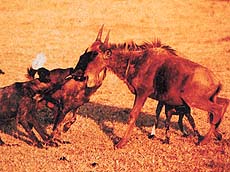












 










 
 
  |
They can
chase away a solitary lion
Wild
dogs hunt in a very systematic manner. They start at
dawn, with animals standing or sitting in a clearing,
calling intermittently in what seems to be a roll call
and pep talk, observes Nutan Shukla
WILD dogs of Asia usually known as
Dholes or red dogs, have a reputation of cruel and
vicious killers. Living and hunting in groups of up to 20
animals, their average home range covers an area of about
15 square miles or 40 sq. km., with boundaries marked by
latrine sites where the Dhole pack urinates and
defecates. In India packs of these animals usually
consist of eight adults and as many pups, all produced by
the same dominant female.
 They hunt in a very systematic manner.
They start at dawn with animals standing or sitting in a
clearing, calling intermittently in what seems to be a
roll call and pep talk. When all have indicated that they
are ready, the pack moves off through the long grass.
Hunting usually during the day and sometimes on moonlit
nights, the leader, a dominant male, stops and sniffs the
air, then freezes. This means he has picked up the scent
of potential prey. One of the pack jumps into the air,
trying to see over the grass. When the pack is satisfied
that the prey is not far away it moves towards it. They hunt in a very systematic manner.
They start at dawn with animals standing or sitting in a
clearing, calling intermittently in what seems to be a
roll call and pep talk. When all have indicated that they
are ready, the pack moves off through the long grass.
Hunting usually during the day and sometimes on moonlit
nights, the leader, a dominant male, stops and sniffs the
air, then freezes. This means he has picked up the scent
of potential prey. One of the pack jumps into the air,
trying to see over the grass. When the pack is satisfied
that the prey is not far away it moves towards it.
These dogs usually adopt
a two-pronged strategy. First they fan out through the
grass in line abreast. The first dog to make contact with
the prey will initiate the attack. The cue for the others
to join in will be the alarm call of the deer and the
sound of the chase. Eyes and ears alert, the pack moves
forward.
Suddenly, the alarm call
is heard and the deer bound away into the nearby forest.
Running like the wind, the pack converges on the position
of the first attacker and gives chase, but the target
deer are too fast. Before too much energy is wasted, the
pack leader calls off the attack. Whistles fill the air
and the pack reassembles.
Now its time for the
second part of the strategy to be adopted. While the rest
of the pack waits at the forest edge, two Dholes trot off
into the trees. Their job is to flush out the prey and
drive it to the direction of other waiting pack members.
If the strategy works, the prey emerges from the forest,
hotly pursued by the stalker. Seeing the ambush ahead,
the prey, which may be an antelope, stops and the
pursuing Dholes attack from behind knocking the prey
off-balance. In an instant, the ambushers pounce,
disembowel it, and, even before the prey is dead, the
pack starts to eat. The animal eventually dies from shock
and loss of blood. Heart, liver and eyeballs are Dhole
delicacies and are devoured first, but the interesting
thing is that there are no squabbles. Competition is
confined only those who can eat the fastest.
Dholes are voracious
eaters and each individual can on an average consume
about 4 kg of meat in one sitting. After the feast is
over, the pack heads for the waterhole. They drink as
frequently as they eat.
A relative of the Dhole
is the African wild dog. While lions rely on stealth and
hyenas on brute force, the wild dogs of Africa are known
for their stamina and determination. Hunting mainly in
the coolness of dawn and dusk, they select their target
amongst a herd of antelopes, often impala and springbok.
Once the victim is selected the dogs will stick like glue
to the chosen prey, throughout the hunt, wearing it down
until the time is right for the kill.
First they isolate the
potential victim from the rest of the herd and two dogs
begin the chase. Meanwhile, the rest of the pack moves
along comfortably, fanning out behind the pursuit. As the
first chasers tire, they return to the pack and the
second pair sets out to take it’s place. The pattern
is repeated time after time. The prey is chased
relentlessly at speeds of up to 70 km per hour.
Eventually, terror and fatigue combine to weaken the
prey. As the prey slows down, the chaser dogs go in,
jumping at the flanks and belly, tearing away chunks of
flesh, and weakening the victim further from loss of
blood. It is never a clean kill. The unfortunate prey
eventually stumbles to the ground.
In an instant and in a
sudden explosion of excited high-pitched chattering the
pack tears at the corpse. These dogs eat so fast that a
medium-sized impala is devoured completely in less than
10 minutes. If the prey is small and the pack big, the
dogs are on their feat once more and alert to the chance
of another meal. Unlike many other animals, wild dogs
rarely scavenge, but when desperate from hunger they have
known to chase away a solitary lion from its kill. 
This feature was published on April 4, 1999
|

